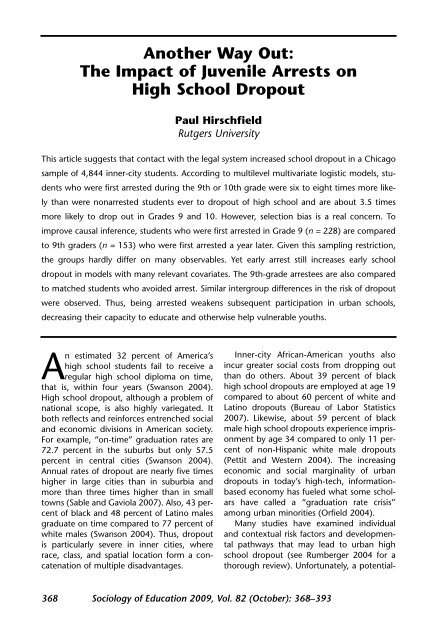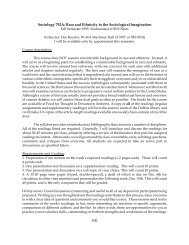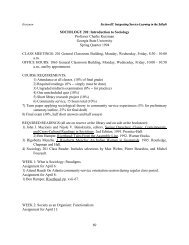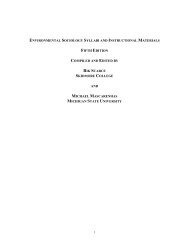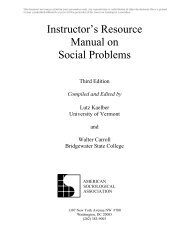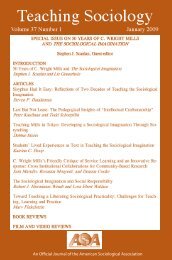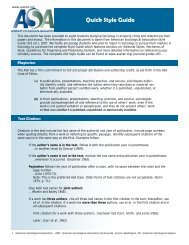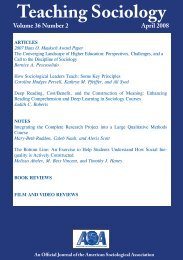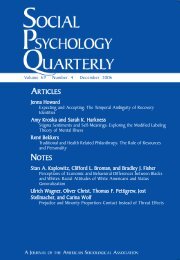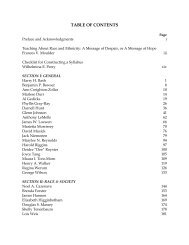SOCIOLOGY EDUCATION - American Sociological Association
SOCIOLOGY EDUCATION - American Sociological Association
SOCIOLOGY EDUCATION - American Sociological Association
You also want an ePaper? Increase the reach of your titles
YUMPU automatically turns print PDFs into web optimized ePapers that Google loves.
Another Way Out:<br />
The Impact of Juvenile Arrests on<br />
High School Dropout<br />
Paul Hirschfield<br />
Rutgers University<br />
This article suggests that contact with the legal system increased school dropout in a Chicago<br />
sample of 4,844 inner-city students. According to multilevel multivariate logistic models, students<br />
who were first arrested during the 9th or 10th grade were six to eight times more likely<br />
than were nonarrested students ever to dropout of high school and are about 3.5 times<br />
more likely to drop out in Grades 9 and 10. However, selection bias is a real concern. To<br />
improve causal inference, students who were first arrested in Grade 9 (n = 228) are compared<br />
to 9th graders (n = 153) who were first arrested a year later. Given this sampling restriction,<br />
the groups hardly differ on many observables. Yet early arrest still increases early school<br />
dropout in models with many relevant covariates. The 9th-grade arrestees are also compared<br />
to matched students who avoided arrest. Similar intergroup differences in the risk of dropout<br />
were observed. Thus, being arrested weakens subsequent participation in urban schools,<br />
decreasing their capacity to educate and otherwise help vulnerable youths.<br />
An estimated 32 percent of America’s<br />
high school students fail to receive a<br />
regular high school diploma on time,<br />
that is, within four years (Swanson 2004).<br />
High school dropout, although a problem of<br />
national scope, is also highly variegated. It<br />
both reflects and reinforces entrenched social<br />
and economic divisions in <strong>American</strong> society.<br />
For example, “on-time” graduation rates are<br />
72.7 percent in the suburbs but only 57.5<br />
percent in central cities (Swanson 2004).<br />
Annual rates of dropout are nearly five times<br />
higher in large cities than in suburbia and<br />
more than three times higher than in small<br />
towns (Sable and Gaviola 2007). Also, 43 percent<br />
of black and 48 percent of Latino males<br />
graduate on time compared to 77 percent of<br />
white males (Swanson 2004). Thus, dropout<br />
is particularly severe in inner cities, where<br />
race, class, and spatial location form a concatenation<br />
of multiple disadvantages.<br />
Inner-city African-<strong>American</strong> youths also<br />
incur greater social costs from dropping out<br />
than do others. About 39 percent of black<br />
high school dropouts are employed at age 19<br />
compared to about 60 percent of white and<br />
Latino dropouts (Bureau of Labor Statistics<br />
2007). Likewise, about 59 percent of black<br />
male high school dropouts experience imprisonment<br />
by age 34 compared to only 11 percent<br />
of non-Hispanic white male dropouts<br />
(Pettit and Western 2004). The increasing<br />
economic and social marginality of urban<br />
dropouts in today’s high-tech, informationbased<br />
economy has fueled what some scholars<br />
have called a “graduation rate crisis”<br />
among urban minorities (Orfield 2004).<br />
Many studies have examined individual<br />
and contextual risk factors and developmental<br />
pathways that may lead to urban high<br />
school dropout (see Rumberger 2004 for a<br />
thorough review). Unfortunately, a potential-<br />
368 Sociology of Education 2009, Vol. 82 (October): 368–393


